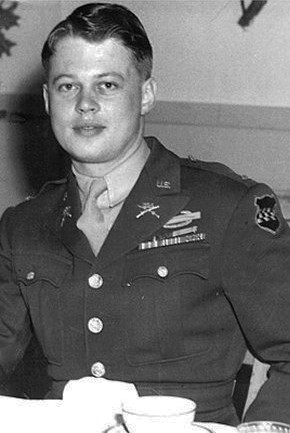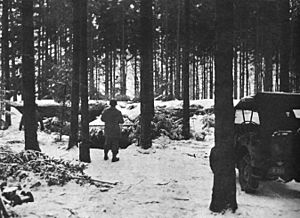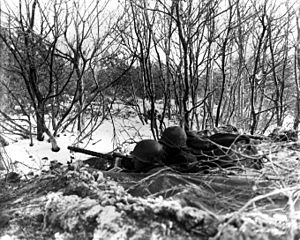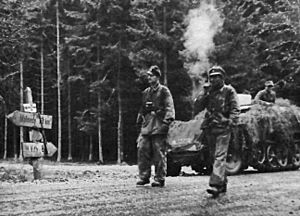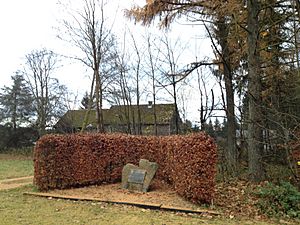Battle of Lanzerath Ridge facts for kids
Quick facts for kids Battle of Lanzerath Ridge |
|||||||
|---|---|---|---|---|---|---|---|
| Part of the Battle of the Bulge, World War II | |||||||
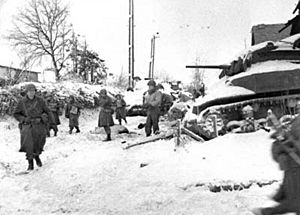 117th Infantry North Carolina National Guard at St. Vith |
|||||||
|
|||||||
| Belligerents | |||||||
| Commanders and leaders | |||||||
| Strength | |||||||
1st Battalion, 9th Fallschirmjäger Regiment, 27th Fusilier Regiment, |
Intelligence and Reconnaissance Platoon, 394th Regiment, Forward Observation Team, Battery C, 371st Field Artillery (4 men) |
||||||
| Casualties and losses | |||||||
| 10-40 killed 63 wounded 13 missing 96 casualties |
1 killed 14 wounded 15 casualties |
||||||
The Battle of Lanzerath Ridge was a brave fight during World War II. It happened on December 16, 1944, right at the start of the Battle of the Bulge. This battle took place near a small village called Lanzerath in Belgium. It was a very important spot for the German army's attack.
A small group of American soldiers, just 18 men from a reconnaissance platoon and four artillery observers, faced a huge German force. This German force was a battalion of about 500 paratroopers. For a whole day, these American defenders fought hard. They caused many injuries to the Germans. More importantly, they delayed the advance of a huge German tank division, the 1st SS Panzer Division, by almost 20 hours. This division was the main attacking force of the German 6th Panzer Army.
Eventually, the Germans managed to surround the Americans at sunset and captured them. Only one American soldier was killed, and 14 others were wounded. The Germans suffered many more losses, with 92 casualties. The Germans then stopped, thinking the nearby woods were full of more American soldiers and tanks. It was only when German tanks arrived much later that they realized the woods were empty.
The American commanders didn't know about the platoon's success because their communication lines were cut. Lieutenant Lyle Bouck, who led the platoon, felt like they had failed because most of his men were hurt and captured. But after the war, Bouck learned how important their actions had been. His small platoon had stopped the German infantry and delayed their tanks for about 20 hours. Years later, in 1981, after much effort from Bouck, every member of the unit was recognized for their bravery. This made them the most decorated American unit of their size in World War II.
Contents
Setting the Scene for Battle
The Battle of Lanzerath Ridge was part of a much bigger German attack called the Battle of the Bulge. Before this, the U.S. Army was trying to capture important dams in Germany. The new 99th Infantry Division was helping another division attack the German West Wall. Even though the Americans expected a counterattack, they didn't know that Germany was moving thousands of soldiers and hundreds of tanks into the area. This part of the front was so quiet that soldiers called it the "Ghost Front."
There was a weak spot in the American lines in the Ardennes forest. This area was not defended by many troops. It was only patrolled by jeeps. The main road for a military attack in this area was through the Losheim Gap. This narrow valley was the key route for the German Sixth and Fifth Panzer Armies.
General Walter E. Lauer, who commanded the 99th Infantry Division, knew his front line was very long and had too few soldiers. He told his division to dig in and build strong defensive positions.
Preparing for the Fight
Young and Ready American Soldiers
The soldiers of the 99th Infantry Division were new to battle. They arrived in the Ardennes in November 1944. Among them was the 394th I&R (Intelligence and Reconnaissance) platoon. These soldiers were very well-trained. They were chosen because they were excellent shooters and in great shape. Some had even been to college.
This platoon was led by 20-year-old Lieutenant Lyle Bouck. He was one of the youngest officers in the whole army. His platoon's job was to set up listening posts, watch the enemy, and go on patrols behind enemy lines to gather information. They were not supposed to fight directly with the Germans. But they still went on dangerous missions, even capturing enemy soldiers for information. Bouck and some of his men were among the first in their regiment to earn the Combat Infantry Badge for their bravery.
On December 10, the platoon was sent to a new spot near Lanzerath, Belgium. This village was very important because it was at a key road junction in the Losheim Gap. Lieutenant Bouck's 25 men were told to fill a five-mile gap in the front line. Behind them were roads that the enemy could use to quickly get behind the American forces.
Building Defenses
The I&R platoon took over positions on a ridge just outside Lanzerath. They were ordered to make their foxholes better and keep in touch with other American units. They dug their foxholes deeper so two or three men could stand and shoot from them. They covered each hole with thick pine logs. Their spot was on a hilltop inside a forest, looking over a field with a barbed wire fence. Their position was about 30 feet above the road and 200 yards from the village. Snow covered their dug-in positions, making them almost impossible to see from the road.
They used a small log hut behind their position to stay warm. Bouck also got more weapons for his unit, including extra rifles and machine guns. He even got an armored Jeep with a powerful .50 caliber machine gun. His men dug a spot for the jeep and its gun, aiming it down the road where the Germans might advance.
They sent a jeep patrol every hour to stay in contact with other units and watch for enemy movement. Bouck said later, "We weren't trained to occupy a defensive position in the front lines. We were trained to patrol and get information about the enemy." On the night of December 16, they heard the sounds of tanks and vehicles in the distance. Bouck told his men to stay awake. It was very cold, with temperatures around 20-30 degrees Fahrenheit.
German Plans
Many German units were made up of new soldiers with little experience. They were often teenagers or older men. The German 3rd Fallschirmjäger Division, which was usually very good, had lost many soldiers in earlier battles. It was rebuilt with new recruits. These new soldiers often had modern weapons but had never used them in a real fight. German officers told their recruits that American soldiers would not be brave enough to fight.
The German plan was for the infantry to attack through Lanzerath first. Then, Kampfgruppe Peiper, a strong tank group, would follow. Their goal was to cross the Meuse River in Belgium. The German commanders knew their plan had problems. They had much less fuel than they needed and hoped to capture American fuel depots. The roads were also narrow, which would slow down their tanks and artillery. This meant that even a small American force fighting hard could cause big delays.
The Battle Begins
German Attack

On December 16, 1944, at 5:30 AM, the Germans started a huge artillery attack. They fired 1,600 artillery pieces along an 80-mile front for 90 minutes. Many shells exploded in the trees, but the American soldiers were safe in their strong foxholes.
German infantry began to move forward even before the artillery stopped. They marched under bright searchlights. At 8:00 AM, the American platoon heard more explosions from other battles nearby. Other American units in the village left without telling Bouck's platoon. This left Bouck's small group as the only American unit in their area.
Lieutenant Bouck saw a long column of about 500 German troops heading towards them. He knew they were Fallschirmjäger, some of Germany's best soldiers. His training hadn't prepared him for being outnumbered 20 to 1. Bouck's phone line to headquarters was cut, but his radio still worked. He asked for permission to pull back, but was told to "remain in position and reinforcements... will come to support you."
One of Bouck's men, Creger, watched as German soldiers walked into Lanzerath. They didn't expect any Americans. Creger radioed Bouck. Bouck sent more men to help Creger. As Creger returned to the American lines, he fought and defeated many German soldiers. Other American soldiers, Robinson, McGeehee, and Silvola, tried to rejoin their platoon but were blocked by Germans. They were eventually captured after a short fight.
Creger and Slape, another American soldier, hid in a house and then a cowshed as Germans searched. They managed to escape through a minefield and woods, fighting more Germans along the way. They finally made it back to Bouck's position. Bouck asked for artillery support, but headquarters didn't believe him about the large German column.
No American Artillery Support
The platoon's position was outside their division's area, so artillery support was hard to get. Bouck waited for artillery fire that never came. He called headquarters again and was told to "hold at all costs." This meant they had to fight until they were dead or captured. Bouck knew that if his platoon failed, the entire American line could be in great danger.
Four artillery observers, led by Lieutenant Warren Springer, joined Bouck's unit. They had been in the village when the other American unit left. Bouck spread them out among the foxholes to help. The radio operator, James Fort, tried to contact headquarters but found the channel jammed with German music. He used Morse code to send a report, hoping the Germans weren't listening.
The Platoon Fights Back
As the German forces moved through Lanzerath, Bouck and his men waited. They wanted to surprise the Germans. A village girl came out and pointed in their direction. The Americans thought she had given away their position and opened fire, hitting several Germans. (Later, it was found she was actually pointing out where the other American unit had left, not where Bouck's men were.)
The German infantry attacked the Americans head-on, charging straight up the hill. The Americans were surprised by these inexperienced tactics. It was like "shooting clay ducks." Many Germans were killed trying to climb over the barbed wire fence. Lieutenant Springer tried to call for artillery, but his radio was destroyed.
The Americans fired constantly. After about 30 seconds, the German attack stopped. Most of the attackers were killed or wounded. Only one American, McConnell, was wounded.
The Germans attacked again around 11:00 AM. No German soldier got past the fence. Bodies piled up around it. German medics waved a white flag to remove their wounded, and the Americans allowed it. But the Americans saw what they thought were German medics sending signals about their position, so the ceasefire ended. In this second attack, only one American, Private Kalil, was wounded when a rifle grenade hit him but didn't explode.
The Germans launched a third attack late in the afternoon, around 3:00 PM. The Americans left their foxholes and fought the attackers up close, pushing them back down the hill. Bouck tried to get reinforcements again. At 3:50 PM, Fort sent the last message to headquarters, reporting they were still holding their position against about 75 enemy soldiers.
As it got dark, Bouck worried they would be surrounded. He planned to pull his men back. He sent two men, Corporal Sam Jenkins and PFC Preston, to find headquarters and get instructions or help. A sniper shot Bouck's radio, and then the jeep's radio, cutting off all communication.
The Germans were hesitant to attack head-on again. Fifty German soldiers were sent to attack the Americans from the side through the woods. Just as Bouck was about to signal his men to retreat, German soldiers broke through their lines. The Americans fought back with grenades. Each foxhole was eventually surrounded. Surprisingly, the Germans didn't kill the defenders. Bouck was pulled from his foxhole and wounded. He surrendered and helped carry his wounded men to the village.
The Fight Ends
During their long fight, the 15 remaining men of the I&R platoon and the four artillery observers fought against about 500 German soldiers. The Germans reported 16 killed, 63 wounded, and 13 missing. Other reports say the Americans caused between 60 and 500 German casualties. Only one American, Billy Queen, was killed. In Bouck's platoon, 14 out of 18 men were wounded. This small American force had seriously delayed the entire German attack. After fighting all day with little sleep and almost no ammunition, they were captured.
What Happened Next
The Germans took over homes in Lanzerath to treat the wounded from both sides. Other homes were used for temporary living quarters.
German Tanks Delayed
The main German tank force, Kampfgruppe Peiper, was made up of 4,800 men and 600 vehicles. They were already behind schedule because of crowded roads and American resistance. Peiper was very angry about the delays. His unit finally reached Lanzerath near midnight.
Lieutenant Bouck, held prisoner in a café, turned 21 years old at midnight. He watched a senior German officer, who he later identified as Peiper, try to find out how strong the American forces were. Peiper was told that the woods and road ahead were full of American troops and tanks. This belief was based entirely on the fierce defense put up by Bouck's small force of just 18 men.
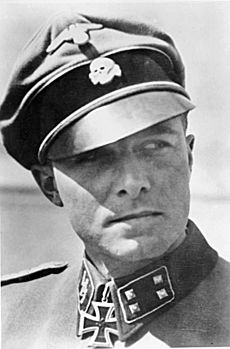
At 4:30 AM on December 17, more than 18 hours late, the German 1st SS Panzer Division finally left Lanzerath. The entire plan for their advance had been seriously slowed. This gave the Americans precious hours to bring in more soldiers and supplies.
The German advance never recovered from this delay. Kampfgruppe Peiper ran out of fuel and came under heavy attack. They had to leave over a hundred vehicles behind. The soldiers had to walk back east. The determined resistance of the American 99th Division, along with other experienced divisions, stopped the German forces from reaching important road networks. If the Americans had given up, the German attack could have changed the outcome of the Battle of the Bulge.
Prisoners of War
The American soldiers from the I&R platoon who could walk were sent to Germany as prisoners. Many were seriously wounded. Bouck was crammed into a single railroad car with 71 other POWs and traveled for days without food or water. By Christmas Day, seven men in his car had died. The prisoners were taken to hospitals and then to different POW camps.
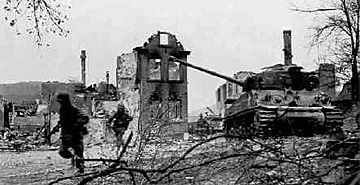
Corporal Sam Jenkins and Private First Class Preston were also captured and joined the others in prison. The men barely survived, suffering from severe lack of food. When American forces tried to free the camp, they were unable to rescue everyone. Bouck was recaptured and finally released just one week before the war ended. He was too weak to write a report and was in the hospital for months. He didn't think his men had done anything special.
Recognition for Bravery
All the wounded and captured soldiers recovered and returned home after the war. In 1965, a book about the Battle of the Bulge briefly mentioned Bouck's platoon. This upset William James, a former platoon member. He contacted Bouck and urged him to get their men proper recognition.
Bouck's former commander nominated him for a Silver Star. In 1966, Bouck received a Silver Star, but no other platoon member was recognized. Later, a book called The Bitter Woods described the unit's actions in detail. After much effort and a special law passed by Congress, every member of the unit was finally decorated on October 26, 1981.
Four men received the Distinguished Service Cross (DSC), five the Silver Star, and nine the Bronze Star with V device. Every man was also awarded the Presidential Unit Citation. They became the most decorated unit of their size in all of World War II.
The platoon members and their awards included:
- First Lieutenant Lyle J. Bouck Jr. (DSC)
- Technical Sergeant William L. Slape (DSC)
- Private First Class William James Tsakanikas (DSC)
- Private First Class Risto "Milo" Milosevich (DSC)
- Private John B. Creger (Silver Star)
- Private Louis J. Kalil (Silver Star)
- Corporal Aubrey P. "Schnoz" McGeehee (Silver Star)
- Private First Class Jordan H. "Pop" Robinson (Silver Star)
- Private James R. "Sil" Silvola (Silver Star)
- Private Robert D. Adams (Bronze Star with V device)
- Private Robert D. Baasch (Bronze Star with V device)
- Sergeant William D. Dustman (Bronze Star with V device)
- Private Clifford R. Fansher (Bronze Star with V device)
- T/3 James Fort (Bronze Star with V device)
- Corporal Samuel L. Jenkins (Bronze Star with V device)
- Private Joseph A. McConnell (Bronze Star with V device)
- Corporal Robert H. "Mop" Preston (Bronze Star with V device)
- Sergeant George H. "Pappy" Redmond (Bronze Star with V device)
- Private First Class Carlos A. Fernandez (Presidential Unit Citation)
- Private First Class John P. Frankovitch (Presidential Unit Citation)
- T/5 Robert L. Lambert (Presidential Unit Citation)
- Private Vernon G. Leopold (Presidential Unit Citation)
- Private First Class Elmer J. Nowacki (Presidential Unit Citation)
- Private Samuel J. Oakley (Presidential Unit Citation)
Lieutenant Warren Springer and his three artillery observers also received the DSC for their bravery. One of them, Billy Queen, was killed in action.
In 2004, a book called The Longest Winter was published, telling the story of the platoon's defense. Bouck worked with the author, Alex Kershaw, but only if the book also wrote about the other men in the platoon.
On May 12, 2005, veterans and local people in Lanzerath, Belgium, put up a monument. It has a small brass plaque, a bench, and a United States flag. This honors the brave fight on the grassy hill overlooking the village.
Images for kids


